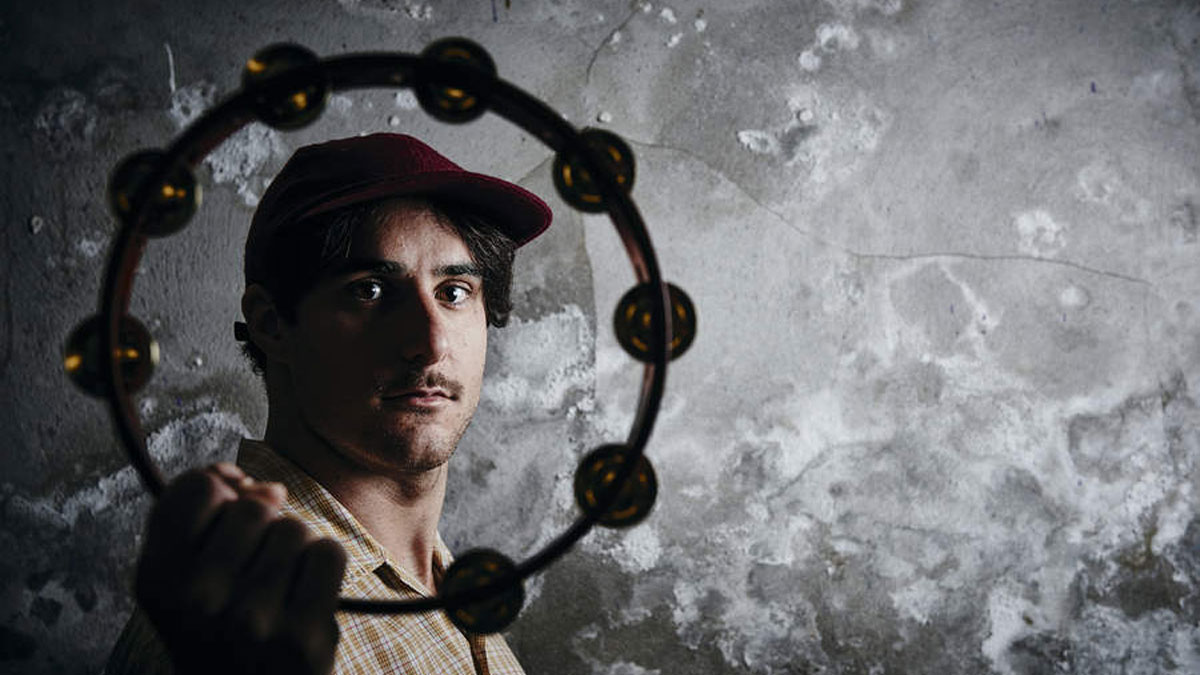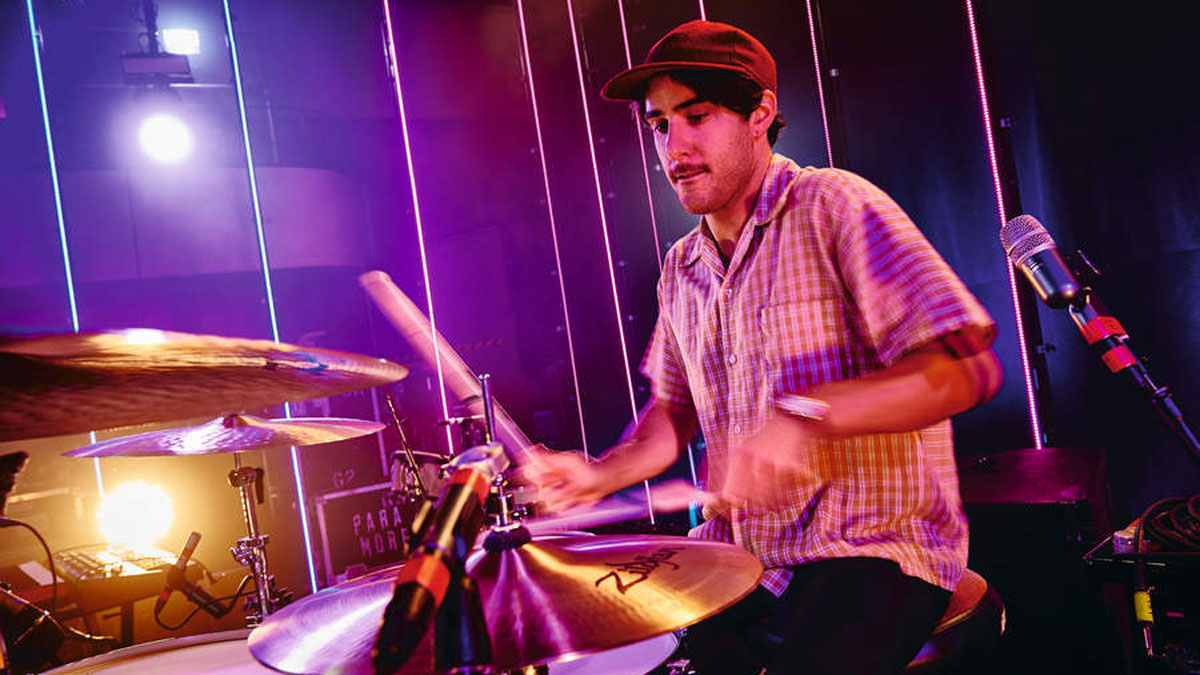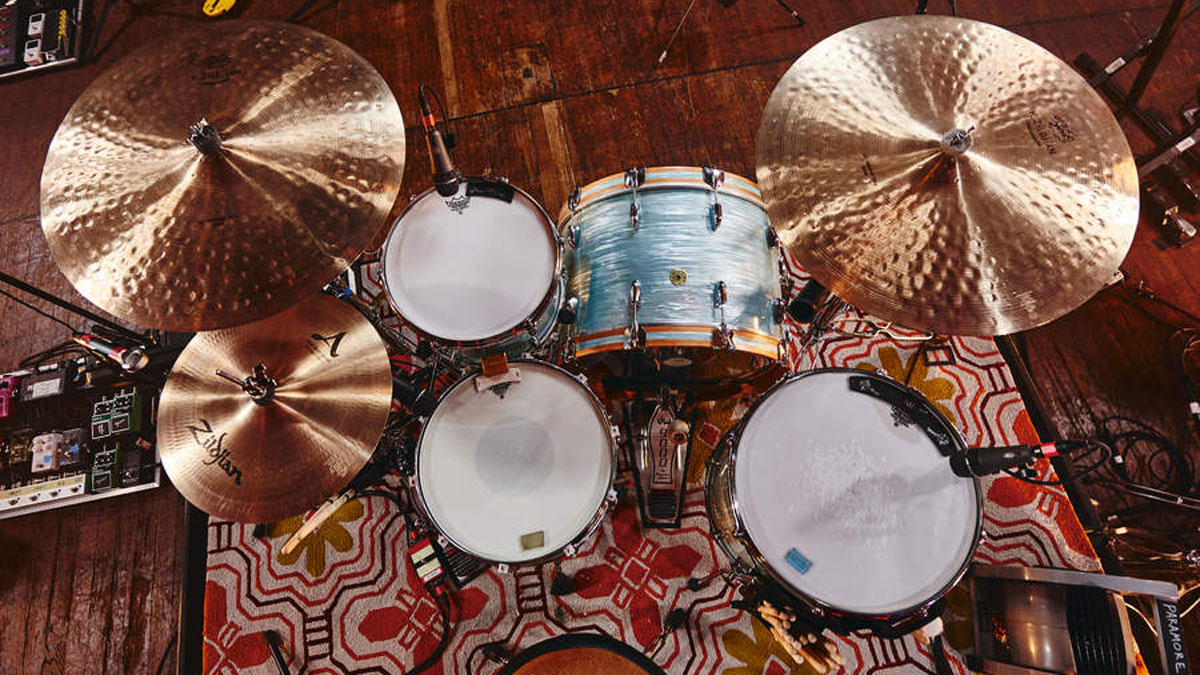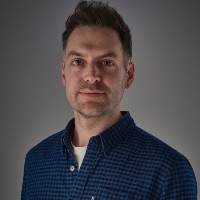Paramore drummer Zac Farro on rejoining the band, HalfNoise and his birthday gift from Taylor York: "It’s been an incredibly cool process"
Farro discusses his return

"I just fell in love with the stuff that Hayley and Taylor were writing."
When Zac Farro and his guitar-playing brother Josh left Tennessee pop rockers Paramore in 2010 it wasn’t clear whether the remaining band members - frontwoman Hayley Williams, guitarist Taylor York and bassist Jeremy Davis - would survive without the chemistry that made the band so special in the first place.
But Paramore did more than just survive, springing back to life and flexing newly-developed songwriting muscles on their 2013 self-titled album, with Nine Inch Nails drummer Ilan Rubin deftly filling in on drums. Paramore spawned mega hits, including the gospel funk stomp of Ain’t It Fun and the driving Still Into You. It was an absolute smash, but Taylor York secretly wished his buddy Zac had been a part of it.
Meanwhile, Zac was playing with other people and working on his own music, most notably indie pop band HalfNoise. Just as his old pals were hitting new levels of musical maturity, Zac was also experiencing his own growth as a songwriter and lyricist, and taking his drumming in a new direction - HalfNoise’s vintage pop beats were a world away from the frenetic barrage of punk pop rhythms in Paramore.
In June 2016, Paramore fans hit fever pitch at news of Zac returning to the studio with Hayley and Taylor (Jeremy Davis left the band in 2015) to record drums for a new album. His official return was announced in February 2017 and After Laughter was released in May.
Where the Zac-less self-titled album was the sound of Paramore growing up, After Laughter marks the trio shedding their ‘rock’ shackles and making the album they’d always dreamed of - that infectious Paramore energy and signature hooks remain, but After Laughter wears its 80s pop influences on its sleeve. Armed with a beautiful ’60s Satin Flame Gretsch and drawing on his musical experiences in HalfNoise, Zac was able to add a tasty new feel and flavour to the album.
The secret was teaming up with bass player/producer Justin Meldal-Johnsen to track their parts live, and the results speak for themselves - warm, grooving and human. We caught Zac before a sold-out gig at Bristol’s Colston Hall to find out about his welcome return to the kit with Paramore, his approach to recording the new album and what Taylor York bought him as a birthday present (clue: it was a drum kit).
You left Paramore in 2010. What drew you back?
“One of the main reasons for me rejoining was I just fell in love with the stuff that Hayley and Taylor were writing. It felt like what we were creating had never been so close to what we were listening to and inspired by. There would be times where we were like, ‘Let’s keep it within the world of Paramore because it has its sound,’ then Taylor would say, ‘I think it’s time to take a new step and a new direction and try some new things. If this is where we’re at, let’s be honest with that.’”
Initially you only came in to play drums on the album, right?
“I was just planning on playing on the record, I wasn’t interested in being asked to be back in the band at all. I was super shocked when, one day, Taylor was taking a break from recording and said, ‘Hey man, you want to join the band again?’ It was so nonchalant. I was like, ‘Dude, of course!’ We just had this slow rebuild of our relationship.”
This incredible journey of starting as friends again, and rebuilding that, and then just discovering music together and hearing Taylor write new stuff, it’s been an incredibly cool process
When did you first re-connect with Hayley and Taylor?
“There were a few years where it was a little odd, because I wasn’t playing in the band and they were touring. About four years back we patched things up and that was really healing as far as our friendship went, and we weren’t even where we’re at right now, playing together and having made an album. It was way before that and it had nothing to do with music. I think that’s why everything’s going so great. We didn’t patch things up for music, we patched things up because of our friendship, then everything came from there. You can go so long with being in a band and it just becomes a job and you go from dressing room to dressing room and you live in your own world. That’s where you lose the magic.
“This incredible journey of starting as friends again, and rebuilding that, and then just discovering music together and hearing Taylor write new stuff, it’s been an incredibly cool process. It’s a new season and it’s really encouraging to hear people say they love the new stuff. I really think it reflects us the best that any album has to date.”
How much music was already written when you came in?
“Taylor was coming up with a lot of the drum parts because he was creating the music and I wasn’t in the band at that point, I was just drumming on the record. There was this funny line of: ‘Okay, obviously we want you to drum on this record because we want your drumming ability and what you bring to the table,’ but there was also some songs that were figured out already. I wondered where I fit in.
“The songs were probably 65-70 percent done, so it was just enough for me to add a few finishing touches to them. Unless you write a song from scratch the drum beat is kind of there. For me, it was adding the little bits in the fills and tweaking. Told You So was just a programmed beat and I took it and made it my own and it became a different thing, but in the realm of what Taylor was going for.
“I wrote three songs with Taylor too. That was one of the first times I’d really written music instead of just the drum parts on a Paramore record. It was kinda new all round.”

"When you’re young you want to play fills on everything..."
You’d been writing music and lyrics, not just drum parts, with HalfNoise during your absence from Paramore. Did that help you approach Paramore songs with a different perspective?
“Yes, 100 per cent. When you’re young you want to play fills on everything, you just want to go nuts and there’s something exciting about that. I still love seeing drummers just go for it and having fun. I also have favourite drummers where some people wouldn’t describe them as the most badass drummer. Like Ringo Starr, you hear a song and it’s not [sings crazy drum noises], but he plays these parts that are so musical. I had been playing for a few different friends, a few different artists and writing my own music in HalfNoise, and I learned so much about the song.
“Songwriting for myself completely helped because it opened the door to understanding there’s so much more to the band than just the drums. Even on this last record I started going, ‘Okay, Hayley’s singing this thing here, so I’m going to emphasise that.’ I never used to think about her words. It really has helped me stand back and go, ‘This guitar part needs to shine.’”
Earlier Paramore albums were rooted in pop rock, with more fills and heavier playing. The drumming on After Laughter is more considered and focused on groove and feel. Did you naturally evolve to playing this way?
“For Paramore, yes. I was like, ‘Wow I’m hitting the centre of the snare instead of playing a rimshot!’ Again, I had a few artists that I played for that were so vastly different to big rock stuff, and there are records I’d played on where now I know I did that so I could play on the new Paramore record.
I was like, ‘Wow I’m hitting the centre of the snare instead of playing a rimshot!’
“I don’t think I’m the most diverse drummer ever, but I’m so thankful I put myself in different places so I’m not just this one-trick pony that has one level. I learned dynamics and I learned playing soft. I used to play softly and get so out of time because I was so used to having one speed, one level. It definitely took me some time and practice, but I was glad I didn’t fully stop drumming [after leaving Paramore]. There wasn’t this dead period of six years of no drumming.” Simpler playing doesn’t always make things easier though... “It still is a challenge at times. There’s this song called Forgiveness [on After Laughter]. It doesn’t sound like a hard song. Our producer Justin Meldal-Johnsen [who also played bass for Beck and Nine Inch Nails] is a monster bass player. He’s just insane. I’m like, ‘Dude, not only have I not played drums in a little bit, but I haven’t played with someone this good probably ever.’ Now that I was playing on the album Taylor wanted to get the live band feel back. Even though Forgiveness is not very live and big, it’s got a lot of dynamics and it’s more polyrhythmic. Even in the energy of a Fleetwood Mac or a Talking Heads song there’s this live push and pull. That’s why you don’t get tired of listening to it. We tried to capture that a little bit.
“Me and JMJ would track live together. For the majority of the time it was just the two of us trying to get our parts down, so it has this real moving piece to it. The more simple songs were the harder ones. It felt almost like Tetris. You’ve got to get everything together and I’m so hard on myself...”
Are you a perfectionist with your drum takes?
“Totally. But also, there are good mess-ups. Does that make sense? You hear this one fill in Here Comes The Sun by The Beatles. It’s so late, but to me that’s Ringo sitting down as a freaking human being going around the drum kit. I think there’s time for really precise playing and I realised that I was too hard on myself. I used to want to be really perfect and if I heard one kick drum out I’d have it fixed. Now I’m like, ‘That one’s a little off but it feels like it should be there because it’s real.’ It was cool to find that on this record too. To be a little bit more human.”

Taylor's Gretsch/Zildjian set-up
Talking of Justin Meldal-Johnsen, the rhythm section on After Laughter is exceptional!
“[In Paramore] it used to be the high gain guitars and smashing the drums and stuff. This time we wanted to have the energy come from a different side, from something other than overdriven guitars. We used the bass and drums and percussion. It’s still got the energy, but it’s not from the same place. Everything has a place and comes in when it needs to. We’re really proud of it, man. It took a long time, but that’s part of it.”
The drum sound is more vintage than what we’re used to hearing from you with Paramore. How did you achieve that?
“They used to call me ‘vintage guy’. I’m wearing a vintage shirt right now, I have a vintage car - an old Mercedes - and I just love pulling inspiration from old records that I really got into like Pet Sounds... Rubber Soul is the most massive record for me. It’s not even a crazy drum record, but more about the songs and where things land. I love The Kinks Are The Village Green Preservation Society, The Stones - pretty much everything from the UK! Then there’s ’60s pop, even French pop; the tones were huge for me. The drums were hit lightly but they were compressed in this way and they just sounded so nice. They were tuned higher too. I was really inspired by the ’60s for the HalfNoise stuff. Then I moved into the late ’70s, early ’80s where you’re talking about Talking Heads and New Order and those drum tones. That kinda all fell into the retro thing for me.
“Taylor wanted to buy a vintage kit for this record. He got a Ludwig and we used it on a couple of songs. One day we were going to get drum heads at this music store and it was my birthday two days later. I saw this kit with this swirly finish. It was a 1960s Gretsch - I think the finish is called Satin Flame. Taylor bought it for me for my birthday and we used it on almost the whole record. For tuning we took that flat, muted approach with a lot of snare weights and sometimes towels.
“Different songs called for different things. Some songs we’d open it up, or we’d put Taylor’s Craviotto kick drum in. It was a bit all over the place because when you’re recording it’s fun to do that.”
Did you do anything special mic-wise?
“We had a bunch of mics just to have the option, then we’d mute what we didn’t need. Taylor wanted to go very minimal on it. We didn’t have a drum tech, but the engineer Carlos de la Garza, who ended up mixing the record, pretty much tuned everything with Taylor.
“The Beatles’ minimal approach of recording is more what I do on HalfNoise. I did this EP in Nashville called The Velvet Face EP and we set up one mono mic, an [AKG] D19 or something. It was the mic The Beatles used for recording strings. We did that for overhead, a kick drum mic and one other room mic. That’s all the mics we used for the whole kit. I played really light and we compressed it and it sounded like that Serge Gainsbourg, The Beatles, Can sound: very small but impactful.”
During the Paramore live show you’re playing older songs amongst the new tracks. Do you enjoy playing your old parts and do you still recognise yourself in them, or are you a completely different drummer now?
“I think it’s a bit of both. I took that time away from the band and I learned so much. I moved to New Zealand for a couple of years and lived so much life. I start playing those songs, like Decode or Misery Business, and it’s like I’m 16 or 17 again. You can’t take the 16-year-old out of the song in a way, but I play so different now too. I have more dynamics and I’ve learned a lot more, even just in life. I feel completely split; part of me is right back there where I was, and part of me wants to play it like I play now.”
HalfNoise became a big part of your life between you leaving and rejoining Paramore. Will your Paramore commitments enable you to continue with that?
“It was never my intention for HalfNoise to be this crazy touring entity band like Paramore. When I was joining Paramore again Hayley and Taylor told me they loved what I do with HalfNoise and not to give it up. We even play a HalfNoise song in the Paramore set! There’s a moment in the show where I leave and go sing and then my drum tech, who is the drummer for HalfNoise, jumps on the drums. He plays percussion live with Paramore as well.
“It’s a challenge, it’s double the work, but when we’re done with this tour I’m going to go record a new EP and just do special shows here and there. It takes such a while for a new band to grow anyway, so I’m so thankful to still be in it in a way. I’m going to let that grow and be free to be whatever it is. If I didn’t have the Paramore thing I feel like I might start thinking I should write something a little more accessible for HalfNoise, instead of letting it just be free.
“It’s really been awesome to keep HalfNoise as this special artistic outlet for me. I physically can’t be touring that right now because I’m doing this, but it’s been working out great so far. I love it, it’s something I have to do for myself. I’ve realised it’s so important for me to express it and get that out, but I’m very split in the middle - it’s also important for me to be playing the drums. I feel so thankful that my life is in a really good space and everything I’m working towards with drumming and writing is the best it’s been in my life. I’m really thankful.”
I'm MusicRadar's eCommerce Editor. In addition to testing the latest music gear, with a particular focus on electronic drums, it's my job to manage the 300+ buyer's guides on MusicRadar and help musicians find the right gear for them at the best prices. I dabble with guitar, but my main instrument is the drums, which I have been playing for 24 years. I've been a part of the music gear industry for 20 years, including 7 years as Editor of the UK's best-selling drum magazine Rhythm, and 5 years as a freelance music writer, during which time I worked with the world's biggest instrument brands including Roland, Boss, Laney and Natal.
